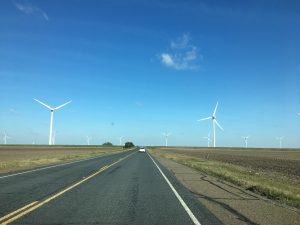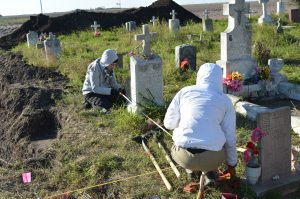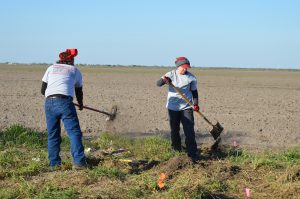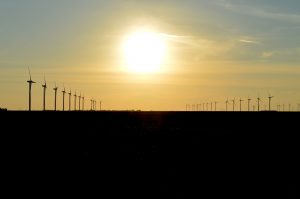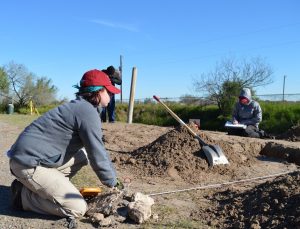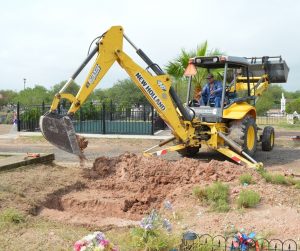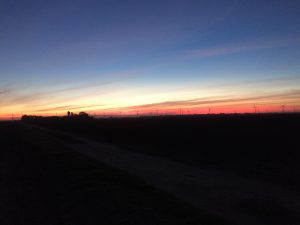 Today we arrived at the cemetery at 6:45 am. While this was quite an early start (especially after a rather late first night), we had quite a beautiful drive from our hotel as we watched the sunrise against endless fields of wind turbines. The air was a chilly 32 degrees F on arrival, but the absence of wind made the morning much more pleasant than day one; in fact, our team began stripping our outer layers rather early in the morning as the rising sun brought much desired warmth topping out at a high of 64 degrees.
Today we arrived at the cemetery at 6:45 am. While this was quite an early start (especially after a rather late first night), we had quite a beautiful drive from our hotel as we watched the sunrise against endless fields of wind turbines. The air was a chilly 32 degrees F on arrival, but the absence of wind made the morning much more pleasant than day one; in fact, our team began stripping our outer layers rather early in the morning as the rising sun brought much desired warmth topping out at a high of 64 degrees.
When 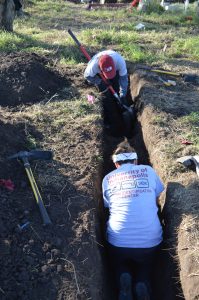 our supplies arrived around 7:15 am we promptly hauled out our tools and hit the ground running. To begin our team split between the trenches we had started on day one with the goal of cleaning up their walls, extending their lengths in either direction, and deepening them to find more potential burials. Basing our trench depths on the depth of the first body bag found in day ones test pit (~60 cm), our trenches were looking rather swell. Jessica, however, was not satisfied with the depth at her end of the western trench insisting that she had a feeling that something lied just beneath the floor despite the concrete-like soil we were encountering. Following her gut, Jessica dug to a depth of about 70 cm uncovering the edge of another bag!
our supplies arrived around 7:15 am we promptly hauled out our tools and hit the ground running. To begin our team split between the trenches we had started on day one with the goal of cleaning up their walls, extending their lengths in either direction, and deepening them to find more potential burials. Basing our trench depths on the depth of the first body bag found in day ones test pit (~60 cm), our trenches were looking rather swell. Jessica, however, was not satisfied with the depth at her end of the western trench insisting that she had a feeling that something lied just beneath the floor despite the concrete-like soil we were encountering. Following her gut, Jessica dug to a depth of about 70 cm uncovering the edge of another bag!
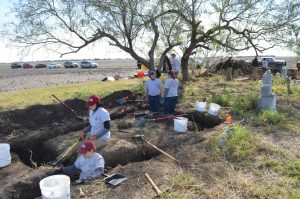 With this new depth info. on hand, we began deepening our trenches even further to ensure we weren’t missing any burials; but Jess still wasn’t satisfied and, following her gut, began digging even deeper. Call it intuition or whatever you please, Jess found the second burial of the day at a depth of about 75 cm. At this point it became clear that we could not expect uniform burial depths, nor could we trust that rock hard dirt meant undisturbed dirt so we all began digging deeper based on the combination of logic and instinct. By around 10 am Leann and Dr. Latham had discovered two more burials at depths of about 85 and 95 cm respectively. Obviously our 70 cm test pits and trenches from day one were severely lacking.
With this new depth info. on hand, we began deepening our trenches even further to ensure we weren’t missing any burials; but Jess still wasn’t satisfied and, following her gut, began digging even deeper. Call it intuition or whatever you please, Jess found the second burial of the day at a depth of about 75 cm. At this point it became clear that we could not expect uniform burial depths, nor could we trust that rock hard dirt meant undisturbed dirt so we all began digging deeper based on the combination of logic and instinct. By around 10 am Leann and Dr. Latham had discovered two more burials at depths of about 85 and 95 cm respectively. Obviously our 70 cm test pits and trenches from day one were severely lacking.
Three of the now four located burials lay in the western trench and (luckily?) they aligned with the rows of gravestones belonging to known individuals in the cemetery and occurring about every other stone. This spacing potentially left room for additional burials in between the three located burials, so we explored these areas as well and discovered an additional two burials bringing our count to six. Up to this point, we had been more concerned with locating burials than uncovering them and, as we continued to extend our trenches, Dr. Spradley from Texas State University delivered great news. The backhoe operator was just finishing up in Texas States’ southern quadrants and would have time to move dirt from our quadrant if we needed. And boy did we need it!
Armed with this new information, w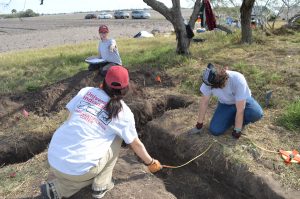 e changed our game plan. Cleaning up the gear from in and around our trenches we prepared our quadrant for Joe, the backhoe driver, and his brother Luis, his spotter. Fortunately, we had a bit of time to do a bit of mapping before they headed over, so out came the tape measures and grid paper. Plotting each of the located burials as well as the trenches themselves, Leann, Sammi, and I knocked out the mapping in no time. In fact, we had enough time that we began to shovel shine and dig test pits in some areas of our quadrant that the backhoe would not be able to reach due to trees and headstones.
e changed our game plan. Cleaning up the gear from in and around our trenches we prepared our quadrant for Joe, the backhoe driver, and his brother Luis, his spotter. Fortunately, we had a bit of time to do a bit of mapping before they headed over, so out came the tape measures and grid paper. Plotting each of the located burials as well as the trenches themselves, Leann, Sammi, and I knocked out the mapping in no time. In fact, we had enough time that we began to shovel shine and dig test pits in some areas of our quadrant that the backhoe would not be able to reach due to trees and headstones.
 Joe and Luis made it to our quadrant with about an hour of daylight remaining, and Jess was placed in charge of overseeing their efforts. As we watched the backhoe work each of us remarked at how efficient it was compared to our hand dug trenches. Within 30 minutes or less a mound of dirt larger than what we had accumulated all day had arisen. The backhoe was, in short, a godsend.
Joe and Luis made it to our quadrant with about an hour of daylight remaining, and Jess was placed in charge of overseeing their efforts. As we watched the backhoe work each of us remarked at how efficient it was compared to our hand dug trenches. Within 30 minutes or less a mound of dirt larger than what we had accumulated all day had arisen. The backhoe was, in short, a godsend.
As the sun began to set, the area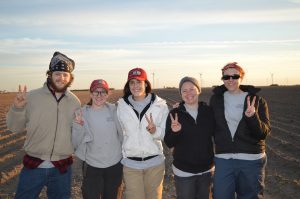 within our trenches was sufficiently cleared and a total of 13 burials were located. This leaves a ton of work for our team to complete in the coming days but with our amazing teamwork and communication, as well as Jess’ killer instincts I am confident that we can get it done in a flash.
within our trenches was sufficiently cleared and a total of 13 burials were located. This leaves a ton of work for our team to complete in the coming days but with our amazing teamwork and communication, as well as Jess’ killer instincts I am confident that we can get it done in a flash.

